
Easter Island is an island and special territory of Chile in the southeastern Pacific Ocean, at the southeasternmost point of the Polynesian Triangle in Oceania. The island is most famous for its nearly 1,000 extant monumental statues, called moai, which were created by the early Rapa Nui people. In 1995, UNESCO named Easter Island a World Heritage Site, with much of the island protected within Rapa Nui National Park.

Hanga Roa is the main town, harbour and seat of Easter Island, a municipality of Chile. It is located in the southern part of the island's west coast, in the lowlands between the extinct volcanoes of Terevaka and Rano Kau. The population of 3,304 comprises 42.63 percent of the total population of the island.
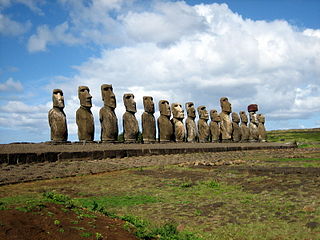
Moai or moʻai are monolithic human figures carved by the Rapa Nui people on Easter Island in eastern Polynesia between the years 1250 and 1500. Nearly half are still at Rano Raraku, the main moai quarry, but hundreds were transported from there and set on stone platforms called ahu around the island's perimeter. Almost all moai have overly large heads three-eighths the size of the whole statue. The moai are chiefly the living faces of deified ancestors. The statues still gazed inland across their clan lands when Europeans first visited the island in 1722, but all of them had fallen by the latter part of the 19th century.

The Rapa Nui are the indigenous Polynesian people of Easter Island. The easternmost Polynesian culture, the descendants of the original people of Easter Island make up about 60% of the current Easter Island population and have a significant portion of their population residing in mainland Chile. They speak both the traditional Rapa Nui language and the primary language of Chile, Spanish. At the 2017 census there were 7,750 island inhabitants—almost all living in the village of Hanga Roa on the sheltered west coast.
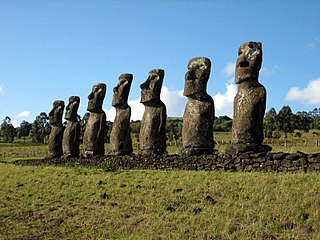
Rapa Nui National Park is a national park and UNESCO World Heritage Site located on Easter Island, Chile. Rapa Nui is the Polynesian name of Easter Island; its Spanish name is Isla de Pascua. The island is located in the southeastern Pacific Ocean, at the southeastern extremity of the Polynesian Triangle. The island was taken over by Chile in 1888. Its fame and World Heritage status arise from the 887 extant stone statues known by the name "moai", whose creation is attributed to the early Rapa Nui people who inhabited the island around 300 AD. Much of the island has been declared as Rapa Nui National Park which, on 22 March 1996, UNESCO designated a World Heritage Site under cultural criteria (i), (iii), & (v). The Rapa Nui National Park is now under the administrative control of the Ma´u Henua Polynesian Indigenous Community, which is the first autonomous institute on the island. The indigenous Rapa Nui people have regained authority over their ancestral lands and are in charge of the management, preservation and protection of their patrimony. On the first of December 2017, the ex-President Michelle Bachelet returned ancestral lands in the form of the Rapa Nui National Park to the indigenous people. For the first time in history, the revenue generated by the National Park is invested in the island and used to conserve the natural heritage.
Chilean mythology includes the mythology, beliefs and folklore of the Chilean people.

ꞌOrongo is a stone village and ceremonial center at the southwestern tip of Rapa Nui. It consists of a collection of low, sod-covered, windowless, round-walled buildings with even lower doors positioned on the high south-westerly tip of the large volcanic caldera called Rano Kau. Below Orongo on one side a 300-meter barren cliff face drops down to the ocean; on the other, a more gentle but still very steep grassy slope leads down to a freshwater marsh inside the high caldera.
Pedro Pablo Petero Edmunds Paoa is a Chilean politician. He serves as mayor of Easter Island Commune. He was previously the Governor of the Easter Island Province from March 2010 to August 2010.
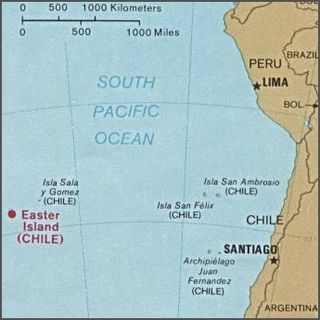
Geologically one of the youngest inhabited territories on Earth, Easter Island, located in the mid-Pacific Ocean, was, for most of its history, one of the most isolated. Its inhabitants, the Rapa Nui, have endured famines, epidemics of disease and cannibalism, civil war, environmental collapse, slave raids, various colonial contacts, and have seen their population crash on more than one occasion. The ensuing cultural legacy has brought the island notoriety out of proportion to the number of its inhabitants.

The Father Sebastian Englert Anthropological Museum is a museum in the town of Hanga Roa on Rapa Nui in Chilean Polynesia. Named for the Bavarian missionary, Fr. Sebastian Englert, OFM Cap., the museum was founded in 1973 and is dedicated to the conservation of the Rapa Nui cultural patrimony.
Indigenous peoples in Chile or Native Chileans form about 10% of the total population of Chile. According to the 2012 census, 2,000,000 people declare having indigenous origins. Most Chileans are of partially indigenous descent, and the term and its legal ramifications are typically reserved to those who self-identify with and are accepted within one or more indigenous groups.
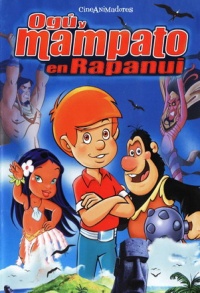
Ogu and Mampato in Rapa Nui, also known as Mampato: The Movie is a feature-length Chilean animated film, created by Cine Animadores and executive produced by Elastic Studios, released June 27, 2002. Although the film isn't the first animated feature made in Chile, being the second after Alfredo Serey's 1921 film La Trasmisión del Mando Presidencial, it is considered the country's first "modern" animated film. The movie is based on the Chilean comics character Mampato created in 1971 for the magazine of the same name by Themo Lobos and Eduardo Armstrong, and later reprinted as the comic-book Cucalón, the story for the film being adapted from the seventh adventure in the series: "Mata-ki-te-rangui".
Carmen Cardinali Paoa is a Rapa Nui Chilean professor. She served as the Governor of Easter Island in the government of president Sebastián Piñera, between 2010 and 2014.
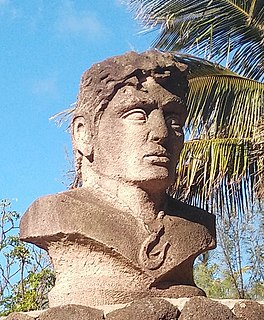
Siméon or Timeone Riro ʻa Kāinga Rokoroko He Tau was the last ‘ariki (king) of Rapa Nui from 1892 until his death. He ruled the island during a brief period of indigenous autonomy between Chile's initial annexation in 1888 and the country's reassertion of colonial authority in 1896. Riro died unexpectedly during a diplomatic trip to Chile to discuss the island's sovereignty with colonial authorities, leading to suspicions that he had been poisoned. Such theories were never proven, although Historians in Santiago Chile keep secret evidence apprehended in the investigation of his death 1898.
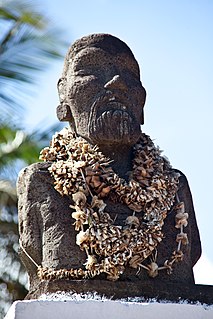
Atamu Tekena or Atamu te Kena, full name Atamu Maurata Te Kena ʻAo Tahi was the penultimate ‘Ariki or King of Rapa Nui from 1883 until his death. He was appointed as the ruler in 1883 by the French Picpus missionaries in the island to represent their interest after a two decade interval in the native kingship caused by the disruptions of Westernization. Although a member of the Miru clan, traditionally associated with the native kingship, he was not a royal of the traditional patrilineal line of kings. In 1888, he signed a treaty of annexation ceding Easter Island to Chile in a ceremony officiated by Captain Policarpo Toro. His name is translated as "Adam the Gannet".
Moisés Jacob Tu‘u Hereveri was elected ‘ariki (king) of Rapa Nui from 1901 until 1902. He was the last Rapa Nui to claim the traditional kingship in the early 20th-century. However, he is generally not remembered as the last king instead his predecessor Riro Kāinga is generally regarded as the last king, although neither held much power. Variation of his family name included Hereveri, Here Veri, Veri-Veri, Beri-Beri, Tueri-Beri, Tueriveri, or Tueriveri.
Enrique Ika a Tuʻu Hati was elected ‘ariki (king) of Rapa Nui in 1900 and led a failed rebellion. He was one of the last Rapa Nui to claim the traditional kingship in the early 20th-century. However, he is generally not remembered as the last king instead his predecessor Riro Kāinga is generally regarded as the last king, although neither held much power.

The COVID-19 pandemic was confirmed to have reached the Chilean island and special territory of Easter Island in March 2020.
Tiare Maeva Carolina Aguilera Hey is a Rapa Nui attorney and politician. In 2021, she was elected to represent the Rapa Nui people in the Chilean Constitutional Convention.











